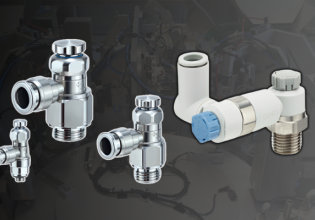Using 3D Inspection to Improve Part Quality Control and Production Yields
Learn about quality control in manufacturing using 3D Inspection, an essential method to achieve quality targets.
A manufacturing company is evaluated, to a great extent, based on the quality of its products; thus, a successful business needs to deliver high-quality products. However, quality goals often contrast with production deadlines because higher quality standards tend to slow down the manufacturing processes.
To achieve a proper balance between these two factors, manufacturing companies implement quality control (QC). In this context, QC is a business function that comprises different processes to ensure products meet quality standards.

Figure 1. QC implements inspections at multiple points to ensure standards are met. Image used courtesy of Newcastle Systems
There are several reasons why QC is important in manufacturing. At the top of the priority list is safety improvements. There should be nothing more important for a company than to reduce or eliminate the possibility of accidents caused by product defects.
Consequently, reducing the likelihood of defects that can cause injuries reduces liabilities for a company. In other words, QC reduces risks for both the company and the customer.
Another important financial reason QC is essential is to minimize or completely avoid product recalls. Advanced QC systems count on tools such as traceability that can reduce the scope of recalls.
To implement QC, the first step is to clearly define the quality standards setting boundaries within product parameters. The next step is to select the appropriate QC method.
There are many different ways QC can be implemented into a manufacturing process. Two of the most common are 100 percent inspections and sample inspections. Many tools can be included in a QC program to further enhance it. Examples of these tools include statistical process control (SPC), six sigma, 5S, and Kaizen.
Once the QC method has been chosen, the next step is to retrofit and implement new inspections into the manufacturing process. After this, QC is an iterative process that continuously improves inspections.

Figure 2. Kaizen is an iterative tool of continuous improvement part of QC. Image used courtesy of Web Kaizen
Among the different inspection techniques available, one stands out among modern manufacturing facilities: 3D inspection. The following sections of this article cover some basics of 3D inspection and applicability in QC.
Basics of 3D Inspection
QC uses 3D inspection to produce results in 3D form. The inspection process uses different sensors and cameras to create a virtual replica of the inspected part. This replica can then be used to review and analyze different parameters of the real part.
A complementary technique called 3D measurement uses specialized software to measure the 3D virtual image, produce reports, and make decisions. There are several common types of 3D inspection.
Laser Scanning
A 3D laser scanning inspection uses a laser device to capture digital images of objects. The laser device shoots a beam toward its surroundings at fast speeds and calculates the time it takes for that beam to bounce back to a receiver in the same device.

Figure 3. A laser device can generate a points cloud of a car part. Image used courtesy of Carolina Metrology
The result of these triangulations produces a cloud of points, which represents all the solid obstacles the laser encounters. Special software then analyzes the points cloud with the possibility of measuring complex shapes with high precision.
Industrial CT Scanning (Tomography)
Also known as industrial tomography, industrial CT scanning uses x-ray technology to scan parts and produce a 3D model. While laser scanning can only detect surfaces, CT scanning can detect surfaces and inner structures, giving the ability to detect internal failures.

Figure 4. Industrial tomography gives more insights into internal product defects. Image used courtesy of Jgarant
Industrial CT scanning is popular in the aerospace, medical, and automotive industries.
Structured Light Scanning
In structured light scanning, specialized structured light sensors project light beams onto the surfaces of the inspected product. The sensor then measures the projected light patterns to generate a 3D model of the product.
This method has some drawbacks due to the complex management of reflectivity from different surfaces. In some cases, products are covered with special layers of paint to avoid incorrect light distortions. Transparent objects are also hard to inspect with structured light sensors.
Benefits of 3D Inspection
The first advantage of 3D inspection is the level of automation that can be achieved. Most vision systems can connect to higher-level applications to communicate inspection results. Fully automated QC 3D inspections perform not only the inspection but also automatically execute actions based on results, such as product rejection. All this can be done while moving the product on a conveyance system.
Laser scanning is relatively accurate, achieving high levels of precision on any kind of surface and form. Also, 3D CAD models can be created starting from a 3D file from an inspection, making 3D modeling more efficient.
Overall, 3D technologies can provide an automated level of QC using various methods. Laser, CT, and structured light scanning can provide feedback of external and internal component structures to verify high-quality products, ensuring safety for customers and reducing liability risk.






